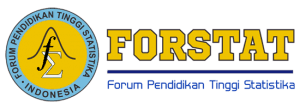DISTRIBUTED LAG MODEL PENGARUH JUMLAH UANG BEREDAR TERHADAP NILAI TUKAR RUPIAH MENGGUNAKAN METODE KOYCK DAN ALMON
Abstract
A regression model that contains the dependent variable which is influenced by the current independent variable, and is also influenced by the independent variable at the previous time is called a distributed lag model. Distributed lag model is a dynamic model in econometrics that is useful in empirical econometrics because it makes a static economic theory dynamic by taking into account the role of time explicitly. There are two distributed lag models, namely the infinite lag model and the finite lag model using the Koyck method and the Almon method in determining the estimated Distributed lag model. This study aims to determine the Distributed lag model for the effect of the money supply on the rupiah exchange rate and determine the best model based on the Koyck method and the Almon method. From the results of selecting the best model based on the SIC value and judging by the more precise R2 of the Koyck method, the resulting model is
t = 7958 + 0.0002Xt + 0.000177Xt-1+ 0.000157Xt-2+ 0.000139Xt-3 + 0.0000123Xt-4
Keywords
Full Text:
PDFReferences
Aqibah, M., Suciptawati, N. L. P., and Sumarjaya, I. W. (2020), "MODEL DINAMIS AUTOREGRESSIVE DISTRIBUTED LAG (STUDI KASUS: PENGARUH KURS DOLAR AMERIKA DAN INFLASI TERHADAP HARGA SAHAM TAHUN 2014-2018)" E-Jurnal Matematika, 9, 240. https://doi.org/10.24843/MTK.2020.v09.i04.p304.
Demirhan, H. (2020), "dLagM: An R package for distributed lag models and ARDL bounds testing" PLOS ONE, (D. Dragan, ed.), 15, e0228812.
https://doi.org/10.1371/journal.pone.0228812.
Fauziyah, E. (2017), "FAKTOR - FAKTOR DETERMINAN KURS RUPIAH TERHADAP DOLLAR AMERIKA" Media Trend, 12. https://doi.org/10.21107/mediatrend.v12i1.2153.
Gujarati, D. N. (2004), Basic Econometrics 4th Edition, Tata McGraw-Hill.
Kennedy, P. E. (2003), A Guide To Econometrics, Cambridge: The MIT Press.
Landa, T. N. (2017), "PENGARUH JUMLAH UANG BEREDAR DAN SUKU BUNGA BI TERHADAP KURS RUPIAH DI INDONESIA PERIODE 2005-2014" Jurnal Online Mahasiswa FEKON, 4, 214-225.
Ningrum, D. K., and Surono, S. (2018), "Comparison the Error Rate of Autoregressive Distributed Lag (ARDL) and Vector Autoregressive (VAR) (Case study: Forecast of Export Quantities in DIY)" EKSAKTA: Journal of Sciences and Data Analysis, 167-177. https://doi.org/10.20885/eksakta.vol18.iss2.art8.
Nurahman, M. C., Wahyuningsih, S., and Yuniarti, D. (2016), "Model Dinamis: Autoregressive Dan Distribusi Lag (Studi Kasus : Pengaruh Kurs Dollar Amerika Terhadap Produk Domestik Regional Bruto (PDRB))" Jurnal EKSPONENSIAL, 7, 139-146.
Salvatore, D. (2019), International Economics, New York: Wiley.
DOI: https://doi.org/10.34312/jjps.v3i1.11805
Refbacks
- There are currently no refbacks.
Copyright (c) 2022 Jambura Journal of Probability and Statistics

This work is licensed under a Creative Commons Attribution-NonCommercial 4.0 International License.







.jpg)






